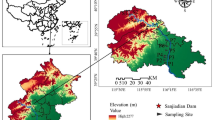Abstract
Composition of the vegetation and the properties of its environment are related, as was shown by research. In these, mostly statistical-correlative studies, both the vegetation and some growth factors, such as plant nutrients and moisture supply were analyzed and studied on interdependence.
At present the environmental conditions can be estimated in the field from the floristic composition with regard to differences both in the combination of plant species and in their relative biomass production.
With a vegetation survey the spatial pattern of the different environmental conditions can be indicated. For instance, the places where moisture supply gradients occur can be detected, also a better understanding is obtained of the environmental equalization and the decreasing number of plant species and spatial diversity.
Conclusions can be drawn about changes in the vegetation to be expected, from the combined occurrence of, a terrestrial vegetation indicating an eutrofied environment and a water vegetation indicating a relatively oligotrophic environment.
By comparing vegetation recordings of the past and present, environmental changes that have occurred in the same place can be indicated.
By vegetations situated in different places in relation with soil profile properties the consequences of environmental changes can be predicted. For instance, lowering of the ground water table and intensifying the agricultural use.
On the other hand, measures can be suggested to increase the biological value of land and water, for instance, indication of seepage areas and floristically rich areas in the field.
Similar content being viewed by others
References
Boer, Th. A. de: 1956 ‘A Rough Survey of the Grassland Vegetation in The Netherlands’, Versl. Landbouwk. Onderz. 625, 1–69, (in Dutch, with extensive summary).
Boer, Th. A. de: 1965, ‘Grouping of Regions on the Basis of Grassland Vegetation’, Neth. J. Agric. Sci. 13, 207–211.
Boer, Th. A. de and Ferrari, Th. J.: 1961, ‘Agricultural and Pedological Indication of Grassland Vegetation Survey Units’, Neth. J. Agric. Sci. 9, 61–70.
Ellenberg, H.: 1974, ‘Zeigerwerte der Gefässpflanzen Mitteleuropas’, Scripta Geobot. Göttingen 9, 1–97.
Kop, L. G.: 1965, ‘Moisture Indication on Grassland by Vegetation and Soil: A Comparison of Maps’, Neth. J. Agric. Sci. 13, 6–20.
Kruijne, A. A.: 1964, ‘The Number of Species in Grassland’, Jaarb. Inst. Biol. Scheik. Onderz. Landb. Gew. 167–175.
Kruijne, A. A., de Vries, D. M., and Mooi, H.: 1967, ‘Contribution to the Ecology of the Dutch Grassland Plants’, Versl. Landbouwk. Onderz. 696, pp. 65, (in Dutch, with extensive summary).
Lange, L. de: 1972, ‘An Ecological Study of Ditch Vegetation in The Netherlands’, Ph. D. Thesis Univ. of Amsterdam.
Vries, D. M. de, Baretta, J. P., and Hanaming, G.: 1954, ‘Constellation of Frequent Herbage Plants, Based on their Correlation of Occurrence’, Vegetatio 5/6, 105–111.
Vries, D. M. de and de Boer, Th. A.: 1959, ‘Methods Used in Botanical Grassland Research in The Netherlands and their Application’, Review Article in Herbage Abstracts 29, 1–7.
Author information
Authors and Affiliations
Rights and permissions
About this article
Cite this article
de Boer, T.A. Vegetation as an indicator of environmental changes. Environ Monit Assess 3, 375–380 (1983). https://doi.org/10.1007/BF00396232
Received:
Issue Date:
DOI: https://doi.org/10.1007/BF00396232




